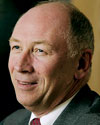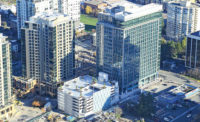...in Songjiang, 35 km from Shanghai. Designed to be part of the Shimao Wonderland theme park, the project includes a green roof as well as geothermal and solar energy.
Atkins’ Middle East business grew fast until last fall, when tumbling building contracts led to 500 job cuts in the region. Among surviving projects is the Lighthouse building, now emerging from Dubai’s International Finance District.
Having last year completed Bahrain’s World Trade Centre building, with three large wind turbines, Atkins claims the 400-m-tall Lighthouse building is greener. With features such as photovoltaic panels, solar water heating and digital lighting controls, the building will use 40% less energy than the local norm.
The Gulf powered the growth of Atkins’s architectural activities. Before Dubai’s boat-shaped, hyper-rich Burj al Arab hotel was built a decade ago, the business was “quite small,” says Clarke.
Failed venture
Atkins does not have a major presence in the U.S. The firm’s plan in the 1990s was to become a significant U.S. engineering consultant, but that faltered with its brief ownership of Oklahoma City-based Benham Cos Inc. At the 1999 acquisition, for $52.3 million, Atkins’ executives foresaw a U.S. business growing to need 3,000 to 4,000 staffers over the next few years.
But the marriage was not happy and ended in 2003 with a management buyout. Benham executives cited cultural differences and disappointing investment as causes of the rift.
F&G’s Hall acknowledges that buying a firm in the middle of the U.S. with no direct flights to the U.K. was not the right first step. Later, with Atkins in financial difficulty, “there was a need to exit the market and reduce cost,” he says.

GLOBAL MANAGING DIRECTOR
FAITHFUL & GOULD
Apart for some oil and gas work in the Gulf of Mexico, Faithful & Gould is Atkins’ U.S. front. It offers independent cost advice to owners of a type common in the U.K. for a century but still rare in the U.S., says Hall, from his Orlando, Fla. office. F&G had been in the U.S. for four years when Atkins bought it in 1996. Its global size has grown to over 2,000, initially by the acquisition of Atlanta-based Hanscomb Inc. seven years ago. Organic growth has boosted F&G’s U.S. payroll to some 600 now.
In the U.S., cost control is entrusted to construction managers or other team members, says Hall. “The track record...has not been very good on the cost side.In the U.S., it is a reactive service rather than proactive,” he adds.
With a recession in the U.S., “costs are much more relevant to people probably than in other circumstances. That’s good from our point of view,” says Hall. “We’ve got a really good footprint and diversity which, through a recession, does put us in a good position to weather the storm.”























Post a comment to this article
Report Abusive Comment